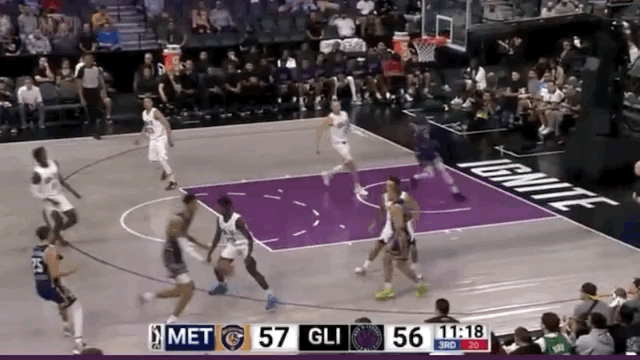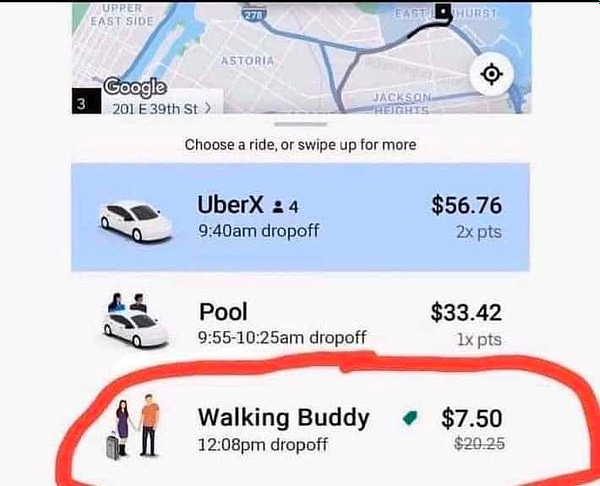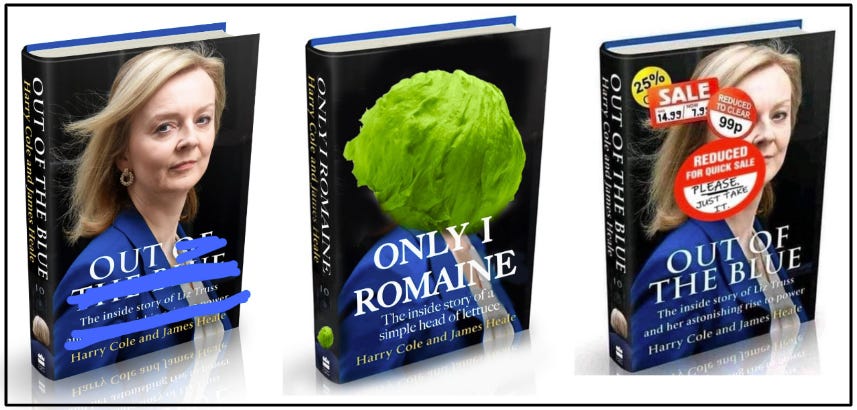Thanks for subscribing to SatPost.
Today, we’re talking about how YouTube is an incredible learning machine.
Also this week:
Apple’s $100B ad opportunity
Why TikTok should be banned
And some dumbs memes (including a new Uber feature )
Today’s SatPost is brought to you by Bearly.AI
Why are you seeing this ad?
Because I co-founded an AI-powered research app called Bearly AI. And I stare at the user metrics 19 hours a day to see if it ticks up. Oh, also, we just added ChatGPT to the Bearly platform (to augment our other reading, writing and text-to-image tools).
The best part: it’s all available in a single keyboard shortcut.
The YouTube Learning Machine
Julius Yego is a Kenyan track athlete.
He won silver for the javelin event at the 2016 Rio Olympics and has been given the glorious nickname “Mr. YouTube”.
Why? Because in Kenya — where most top athletes gravitate to long-distance running — Yego went against his dad’s wishes and taught himself how to be a world-class javelin thrower…by watching YouTube highlights.
Literally.
Yego’s “mentor” was a collection of video clips from Norwegian track athlete Andreas Thorkildsen (YouTube smartly capitalized on Yego’s story by making a “Congratulations, Julius Yego” video).
The training background is covered in one of my favorite articles in recent years: Samo Burja’s “The YouTube Revolution in Knowledge Transfer”.
Burja — a sociologist and political consultant — made the case for why YouTube may be historically as impactful as the printing press, specifically on the dimension of learning.
Apologies for the long block quote, but it’s well worth the read:
“Yego’s rise was enabled by YouTube. Yet since its founding, popular consensus has been that the video service is making people dumber. Indeed, modern video media may shorten attention spans and distract from longer-form means of communication, such as written articles or books. But critically overlooked is its unlocking a form of mass-scale tacit knowledge transmission which is historically unprecedented, facilitating the preservation and spread of knowledge that might otherwise have been lost.
Tacit knowledge is knowledge that can’t properly be transmitted via verbal or written instruction, like the ability to create great art or assess a startup. This tacit knowledge is a form of intellectual dark matter, pervading society in a million ways, some of them trivial, some of them vital. Examples include woodworking, metalworking, housekeeping, cooking, dancing, amateur public speaking, assembly line oversight, rapid problem-solving, and heart surgery.
Before video became available at scale, tacit knowledge had to be transmitted in person, so that the learner could closely observe the knowledge in action and learn in real time — skilled metalworking, for example, is impossible to teach from a textbook. Because of this intensely local nature, it presents a uniquely strong succession problem: if a master woodworker fails to transmit his tacit knowledge to the few apprentices in his shop, the knowledge is lost forever, even if he’s written books about it.”
YouTube changes the equation and Burja says its rise as a learning machine is a confluence of major tech trends over the past few decades: 1) widely available cameras of decent quality; 2) internet everywhere; 3) search engines that can unearth niche topics; and 4) small screens (AKA smartphones) to consume the content.
I couldn’t stop thinking about Burja’s ideas while watching highlights from two young basketball players: Chet Holgrem and Victor Wembanyama.
Holgrem is 7’1 and recently drafted by the NBA’s Oklahoma City Thunder. He’ll miss the new basketball season because of a foot injury but this highlight (left) from the pre-season showed an uncanny resemblance to an advanced shot perfected by Hall-of-Famer Dirk Nowitzki (right).
There’s a big difference in these clips, though. Holgrem is a 20-year old rookie while the Nowitzki clip is from 2011, when the German basketball star was 33 years old and had spent decades perfecting the skill.
And Dirk didn’t have YouTube; he learned from a legendary German shooting coach named Holger Geschwinder, who used to do the most insane basketball drills. It was pure 1-on-1 “transfer tactile knowledge down to the next generation” training but, now, millions of youngsters can learn Holger’s techniques — and the finished Dirk product — from watching YouTube.
Even more impressive is Wembanyama, a 19-year old Frenchmen who may be the best NBA prospect ever (he’s eligible to enter the league next year). At 7’4 with an 8’0 wingspan, Wembanyama somehow towers over both Holgrem and Nowitzki…and has even more nimble guard-like skills.
Now, I couldn’t find either Holgrem or Wembanyama saying that they used YouTube to train. But I’d bet a lot of money that these two — while growing up — tapped into the explosion of basketball highlights and training vids on YouTube to level up their skills.
Joel Embiid — the 7’0 star centre for the Philadelphia 76ers — credits YouTube for his own development. Born in Cameroon, Embiid came to America as a 16-year old. He had size but no basketball skills. Here’s how he learned to play according to an essay Embiid wrote in The Players’ Tribune:
“So I’m chilling one night, and I go on YouTube, and I’m thinking I’m about to figure this shooting thing out. I go to the search box like….
HOW TO SHOOT 3 POINTERS. Nah.
HOW TO SHOOT GOOD FORM. Nah.
Then the light bulb went off, man. I typed in the magic words.
WHITE PEOPLE SHOOTING 3 POINTERS.
Listen, I know it’s a stereotype, but have you ever seen a normal, 30-year-old white guy shoot a three-pointer? That elbow is tucked, man. The knees are bent. The follow-through is perfect. Always. You know how in America, there’s always an older guy wearing like EVERLAST sweat-shorts at the court? That guy is always a problem. His J is always wet.”
“…I seriously got to the league by watching YouTube and living in the gym. There’s no other way to explain it.”
Aside from being one of the funniest things I’ve ever read, Embiid’s story is another salient example of “YouTube as a tactile learning machine”.

Yego’s YouTube training regimen was similarly a solo endeavour:
First time I was in YouTube is 2009, when I was now getting serious about training and I didn't have a coach. Nobody was there for me to see if I was doing well or not, so I went to the cybercafe.
I needed to go and see what these guys were doing...the kind of training they had, the kind of training they were doing in the gym.
Most top athletes won’t take the Yego or Embiid route. High-potential prospects quickly get funnelled into proper training programs and youth leagues. But it’s clear that if some of the world’s top athletes in their respective sports can find success with YouTube and very very dedicated practice, an opportunity exists in countless other “tacit knowledge” fields.
YouTube has 2B+ monthly active users and one Pew survey found that 51% of users are on the platform to figure out “how to do things they haven’t done before”. Last month, YouTube rolled out new learning features — like interactive tools and pop-up quizzes — but there’s still so much opportunity ahead.
For those wondering about TikTok, I think YouTube has the advantage because of longer videos, established mindshare for education and better search (it’s owned by Google, after all).
As for my favorite tacit knowledge video ever, it’s Gordon Ramsay cooking a Christmas Beef Wellington. I haven’t actually cooked one yet (I just love the video). But when I do, it’s going to be incredible and my family will start calling me Mr. YouTube.
(PS. YouTube also taught me how to stroke a nice off-the-dribble jumpshot while no one is guarding me lol. And I was fortunate to interview two of my favorite basketball YouTube channels earlier this year -- BBall Breakdown and ShotMechanics)
If you’re not a subscriber, toss your email here for more glorious business and tech takes every Saturday:
Links and Memes
Apple’s $100B ad opportunity: There are ~2 billion active iPhones in the world. Meanwhile, Apple knee-capped the entire digital ad industry with a new app privacy policy last year (Meta says it’ll lose out on $10B in advertising from the change). Now, the Cupertino giant wants to fill the ad vacuum.
Turner at The Split newsletter breaks down how Apple can fully monetize various parts of its ecosystem — App Store, Apple News, Apple Maps, Lock Screen / Notifications, iMessage — to build a $100B ad business.
Or Apple could just make this instead (the to-iLet):
TikTok should be banned: Earlier this month, the US government dropped a hammer on China’s semiconductor chip industry (my buddy Jordan at ChinaTalk is a must-read on the topic and all things China tech). Now, a lot of people are wondering, “is TikTok next?”.
America should def ban the app: it’s become way too influential for under-30s in the country and the Chinese Communist Party (CCP) sits on the board of TikTok’s owner, Bytedance (oh, and China already bans every single US website…even Pinterest for crying out loud!).
Here’s a historical analog: the current situation would be like if the Soviet Union owned any of the Big 3 US broadcasters (ABC, NBC, CBS) during the Cold War.
We don’t know for sure if the CCP is accessing user data or influencing the algorithm. But the fact that it can makes TikTok a big enough threat. Yes, other US apps do f***kery but they are US-owned apps. And if the US government needed another nudge, here’s the latest from Forbes: “TikTok Parent ByteDance Planned To Use TikTok To Monitor The Physical Location Of Specific American Citizens”.
Ben Thompson’s wrote a strong case for banning TikTok back in 2020 (and, today, he believes a TikTok ban would mean a forced sale of the app to a US owner).
Other solid links: I thought HBO’s week-to-week episode cadence was the best way to build hype but Netflix says internal data shows that its binge-release strategy drives “substantial engagement” and the streamer will keep doing it. (Link) Snoop Dogg made an appearance on the Wheel of Fortune game show…and the result is as funny as it sounds. (Link) “Quick update from the annual french stretchy cheese competition — they're reaching absolutely ridiculous levels of stretch”. (Link)
…and here are some gold tweets.
In effort to diversify revenue streams, Uber invented walking…
(Editor’s note: the above Uber photo is actually photoshopped…but I initially fell for it. However, Uber is launching an in-app ad program in addition to its UberEats ad offering. The ride-share firm is aiming for $1B in gross as bookings by 2025).
Crypto was the hot VC investing sector in 2021 but has since given way to creative AI in 2022. Meanwhile, two AI firms reached unicorn status this week — Stability AI and Jasper AI (check out Ben Tossell’s newsletter for the latest on AI). Here's a thematic tweet...

The Twitter main character this week was Liz Truss, the former British Prime Minister who lasted 45 days on the job. Truss blew up her premiership by dropping an ill-advised “mini-budget” a few weeks ago. Things were so bad that a British paper ran a livestream of Truss and a head of lettuce with maybe the greatest chyron ever: “Can Liz Truss outlast this lettuce?” (She couldn’t).
Anyways, when Truss resigned as British PM on Thursday, people started pointing out that 2 authors had written a book about Truss that’s slated to come out on December 8th. It’s called “Out of the Blue: The Inside Story of Liz Truss and Her Astonishing Rise to Power” (ooooof). These memes riffing on the "Out of the Blue" book cover are elite:












